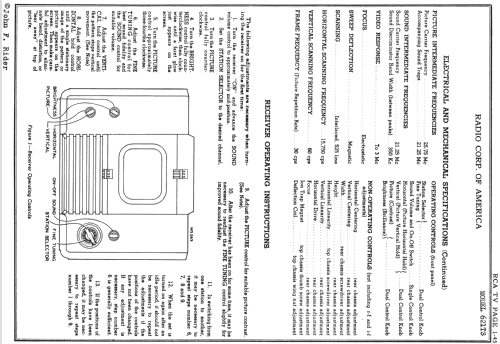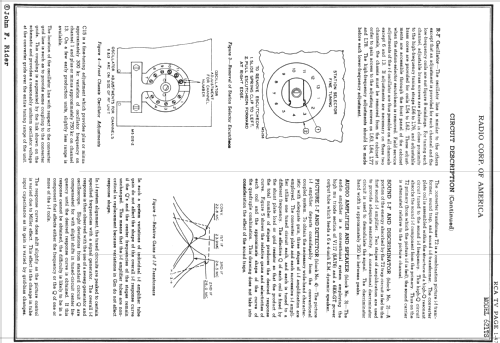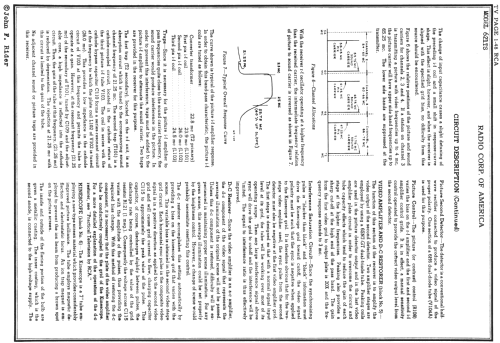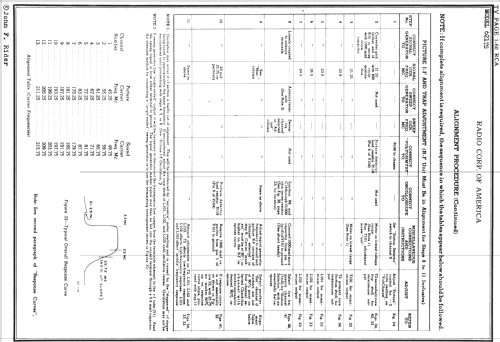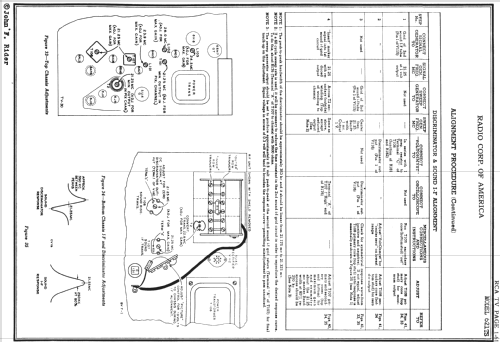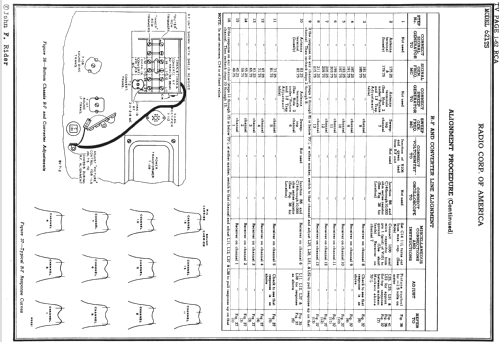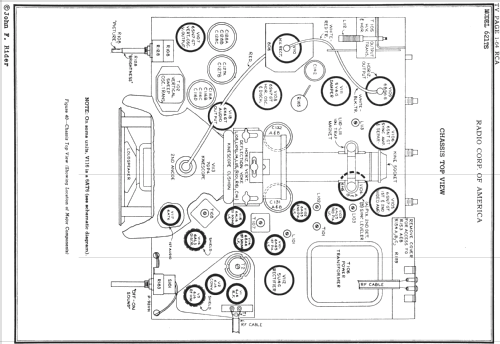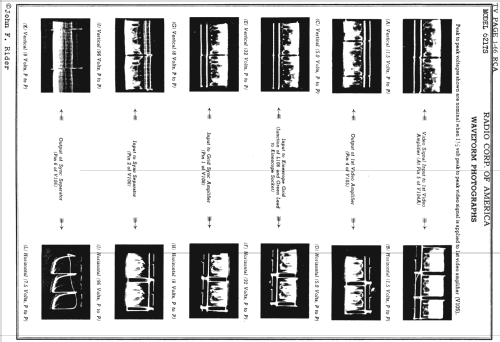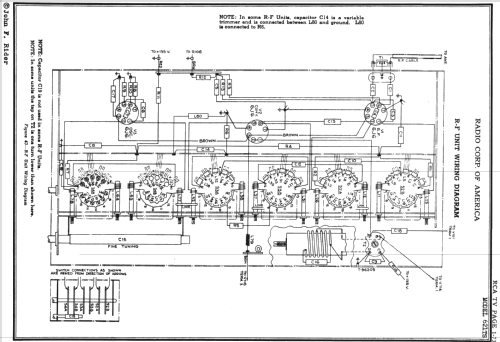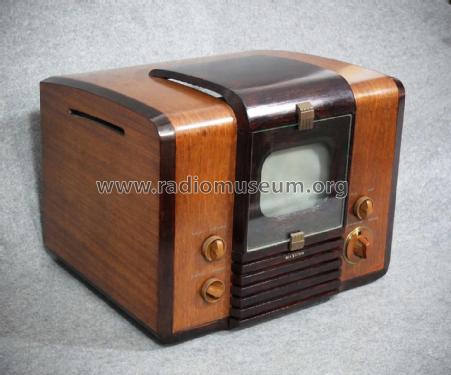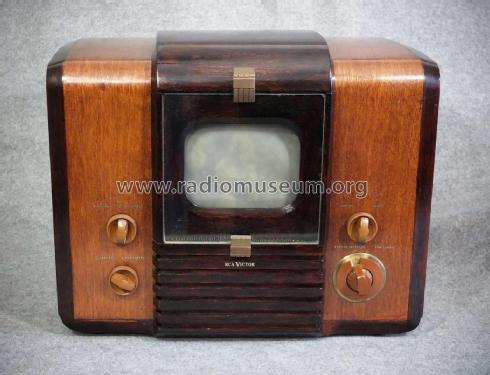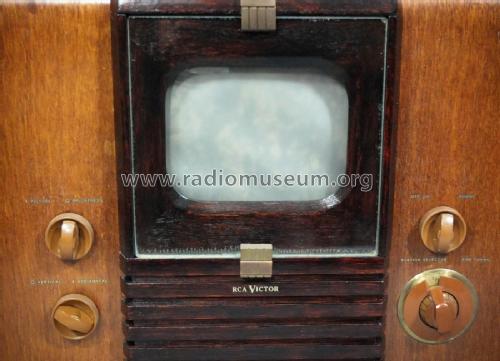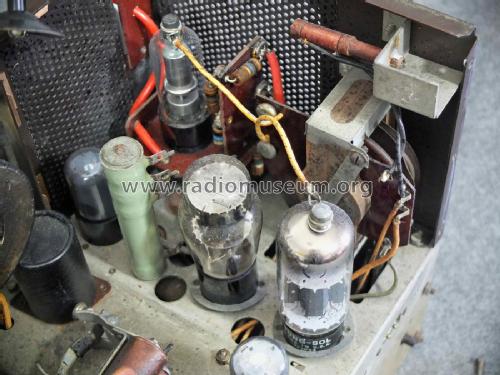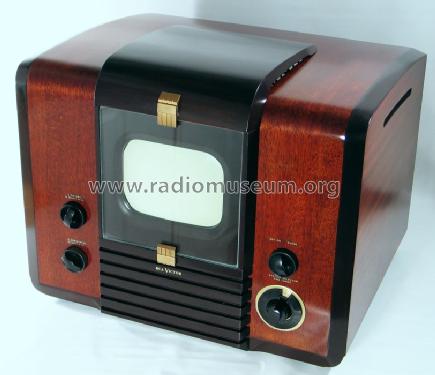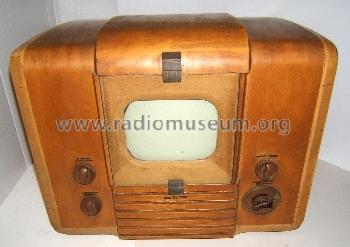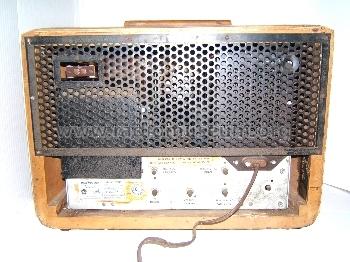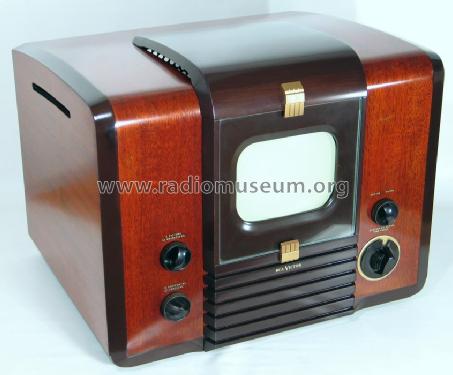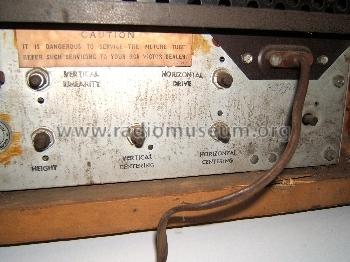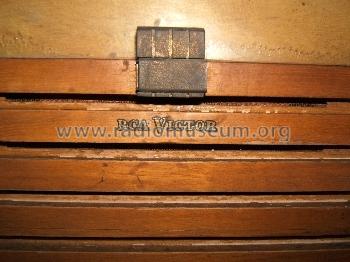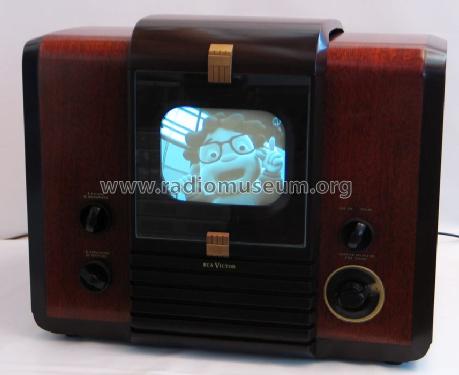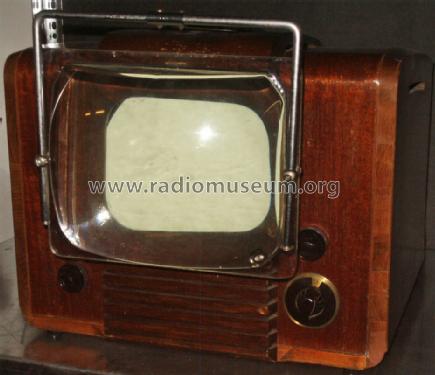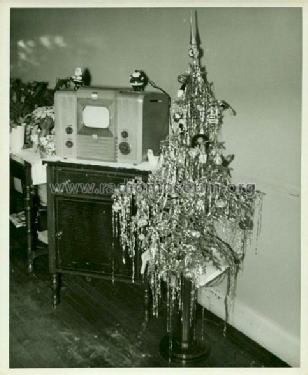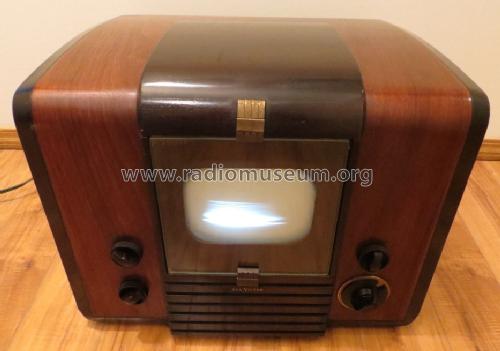- País
- Estados Unidos
- Fabricante / Marca
- RCA (RCA Victor Co. Inc.); New York (NY)
- Año
- 1946/1947
- Categoría
- Televisión (TV) o monitor
- Radiomuseum.org ID
- 83988
-
- alternative name: RCA Manufacturing || Victor Talking Machine
Haga clic en la miniatura esquemática para solicitarlo como documento gratuito.
- Numero de valvulas
- 20
- Válvulas
- 7DP4 6AU6 6AG5 6AG5 6AG5 6BG6G 6J6 6J6 6J6 6AT6 6AT6 6H6 6BA6 6K6GT 6SN7GT 6SN7GT 6SN7GT 6SN7GT 5V4G 5U4G 1B3GT or 8016
- Principio principal
- Superheterodino en general
- Tensión de funcionamiento
- Red: Corriente alterna (CA, Inglés = AC) / 115 Volt
- Altavoz
- Altavoz electrodinámico (bobina de campo) / Ø 6 inch = 15.2 cm
- Material
- Madera
- de Radiomuseum.org
- Modelo: 621TS - RCA RCA Victor Co. Inc.; New
- Forma
- Sobremesa alto de forma simple.
- Ancho, altura, profundidad
- 19 x 15.25 x 16.25 inch / 483 x 387 x 413 mm
- Anotaciones
-
First RCA TV set after WWII;
- 7" Round Picture Tube 7DP4
- 17000 were manufactured
- VHF Tuner with 13 Channels
The 621TS is a remarkable television set. It represents RCA’s first post-WW2 production effort and incorporated the design ideas of pre-war television technology.
It also incorporated revolutionary new design changes such as Line Output efficiency damping, FM sound, complex Line Output transformer core metallurgy, and improvements in CRT design.The set has a 7-inch screen deploying a 7DP4 CRT. The 7DP4 has an 8 KV maximum EHT voltage type, typically 6 KV, uses an ion trap magnet, and provides a very bright high contrast picture.
It became standard practice in the post-war period to enclose the line output transformer and EHT rectifier in a separate cage, shown on the lower right of the chassis. The Power transformer, the lower left was mounted on the chassis under surface to keep it as far as possible from the CRT to avoid the effect of magnetic interference with the beam.
The 621TS was designed to receive the standard American VHF range of TV station frequencies for channel 1 (45.25 MHz video carrier, 49.75 MHz sound) to 13 (211.25 MHz video, 215.75 MHz sound).
- Peso neto
- 21 kg / 46 lb 4.1 oz (46.256 lb)
- Precio durante el primer año
- 225.00 $
- Procedencia de los datos
- -- Collector info (Sammler)
- Mencionado en
- Radio Retailing (Radio & Television R.) (November 1946 page 148.)
- Documentación / Esquemas (1)
- Silicon Chip, Dec 2022, Page 94.
- Autor
- Modelo creado por un miembro de A. Ver en "Modificar Ficha" los participantes posteriores.
- Otros modelos
-
Donde encontrará 5143 modelos, 3250 con imágenes y 4180 con esquemas.
Ir al listado general de RCA (RCA Victor Co. Inc.); New York (NY)
Colecciones
El modelo 621TS es parte de las colecciones de los siguientes miembros.
Museos
El modelo 621TS se puede ver en los siguientes museos.
Contribuciones en el Foro acerca de este modelo: RCA RCA Victor Co.: 621TS
Hilos: 1 | Mensajes: 2
The RCA 621TS television was RCA's first post-war TV, and marked the beginning of the rapid adoption of TV in the U.S. starting in 1946. Its historical significance, interesting Vassos-designed cabinet (similar in some respects to pre-war sets), and relatively small size make it a desirable model among antique TV collectors today.
Electrical repair of this set involved the following:
- All paper and electrolytic capacitors were replaced.
- A metal whisker on the height control caused a short circuit to the chassis, preventing the vertical oscillator from functioning. Removal, cleaning, and reinstallation of the original control solved the problem.
- One resistor in the focus voltage divider (R172 on the Rider schematic, 6.8M 2 watt) had increased in value substantially, preventing proper focus within the range of the focus control. Problem solved by replacement of resistor.
- Synchronization stability was improved by replacing R132 (4.7K) on the Rider schematic; this resistor had increased in value beyond its tolerance range.
- A number of other out-of-spec resistors were replaced, although none was found to impact set performance.
- Sound IF was significantly out of alignment, resulting in distorted audio and lack of coincidence in the best fine tuning position for the sound and video. Complete video and sound IF alignment was performed according to instructions in Rider. Sound was improved, but there was noticeable background hiss when using a DTV converter. Investigation and consultation with others suggested this is caused by either amplitude or phase noise on the aural carrier. Early TVs with split IF (rather than intercarrier IF) can be susceptible to common mode phase noise on the video and IF carriers, while newer intercarrier designs are immune to such common mode phase noise. Modern video modulators might not be designed with quiet enough common mode phase noise, since modern sets don't have this problem (they are primarily sensitive to differential phase noise between the video and sound carriers). Trying different modulators gave different hiss levels, lending credence to this theory. A more careful end-to-end alignment of the full sound IF chain, aligning for perfect symmetry of the FM discriminator transfer curve also resulted in hiss reduction, which suggests that some of the hiss may be due to amplitude modulation noise, which is best suppressed when symmetric FM demodulator response is achieved.
- The original 7DP4 CRT showed an unusual intermittent problem. An initial test showed zero emission. After running with elevated filament voltage (9 volts) for approximately 30 minutes (a procedure which often improves emission on CRTs that have not been used for many years), the emission suddenly jumped fully into the "good" range (quite different than the usual gradual increase in emission with this procedure). For the first few days of use, it was necessary to apply elevated filament voltage for several minutes to get the CRT to start working each time the set was turned on; after that it would function normally at nominal 6 volt filament voltage. After doing this for several days, the CRT stabilized and functioned normally for two weeks without need for elevated filament voltage. After reinstalling in the cabinet, the original intermittent behavior returned, and was again fixed by using elevated filament voltage when first using the CRT several times over a few days. After that, the CRT seems to have stabilized again.
Although this set is a very early design, the circuitry is "modern" in several respects, with magnetic deflection, electrostatic focus, and a flyback transformer to generate high voltage. Like many early sets, it lacks an automatic gain control, and uses a magnetic ion trap to protect the non-aluminized CRT.
Video performance is outstanding for such an early design, vastly outperforming the more common 7-inch sets with electrostatic deflection. Note the sharpness of the picture:

Cabinet restoration presented some special challenges. As found, the set had cracked safety glass, significant damage to the wood on the speaker grill, multiple scratches and dents, and severely faded finish:

After stripping the original finish and disassembling, the speaker grill was repaired with wood filler:

Since the original finish was so faded, some research was required to figure out what the original color was. The RCA 621TS was originally available in three colors: mahogany, walnut, and blond. Although it first appeared this might be the walnut version (due to the uniform coloring of the main cabinet, speaker grill, top, and CRT mask), examination of the wood, and observation of the areas of the original finish that were protected under the speaker grill indicated that this set originally had a mahogany finish, with a much darker tone on the speaker grill, CRT mask, and top. Note the much darker colors visible in the areas that were protected (not just the mahogany finish on the main cabinet, but also the very dark original tone where the brass window retainer brackets covered part of the top front of the speaker grill and the center front of the top cover):

Pictures of other restored 621TS sets were also consulted. Final appearance of this set after refinishing matches the intended colors:

The missing correct knobs and the channel selector ring were obtained from another collector. Reproduction decals for the controls and the RCA Victor logo were purchased from Radio Daze. Replacement safety glass was purchased from a local glass supplier. A reproduction back panel was purchased from Amptech Systems, making the set 100% complete.
Thomas Albrecht, 03.Sep.09



